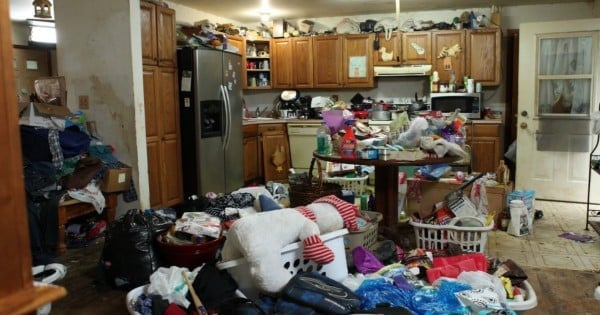
“I had a bedroom, but it wasn’t my bedroom.”
“It had four walls and my bed but I couldn’t go in and play. I made a pathway through to the bed but eventually everything got so piled up I couldn’t lie down.”
Sarah Pinheiro’s earliest memories aren’t of an event or a moment but of things.
Of clutter.
Of piles of furniture and clothing. Of reams of junk, boxes. Animal faeces. Newspapers, catalogues, rubbish.
Of rats and mice and cockroaches.
Her home.
Now aged 31 she has spoken to The Age about what it was like to grow up as the child of a hoarder in Victoria alongside 52 guinea pigs, three cats, chickens, rabbits, dogs, mice and rats.
“When I lived there you couldn’t even see the back wall,” she said.
She explained that to have a shower she had to climb out over the rubbish to get to the bathroom, and that eventually, as her mother’s problem got worse, the ensuite was the only room in the house her mother could sleep in as it had the only space.
Sarah explained that as a child she was too afraid to go near the freezer as stored there, among the frozen peas and ice cubes was Fred, her pet cockatoo. When he died her mother wrapped him in plastic and placed him in the freezer and there he lay for years.
She told The Age that her childhood was spent missing out, she couldn’t have friends over to visit, nor do ordinary things other children did. She says that her only relief was ballet, but that she was constantly scared.




Top Comments
My Mom is a paranoid scizophrenic and a hoarder. When I was a kid, my dad would try to haul stuff out of the house and there would be a knock down drag out and she would stop him from cleaning up. We never had a friend. We never had a family member over. When I say "never" you are like, oh, that is an exaggeration. No, actually, we were entirely isolated. We were also dirt scraping poverty poor. We had limited food. We did not have a phone. I was brutally and mercilessly abused at school, and then came home to the hoard of shame. My dad stayed away most of the time and we never had a meal together except outside on a charcoal fire, which was our way of eating when the power was out in the Summertime, and also we sometimes went to the Burger King or KFC or Ponderosa Steak House. My dad was not in great shape himself, he had horrible anxiety and depression. Everyone loved my Mom because she always brought things to school for parties, and she meant well, which is why it is so hard for me to come to grips with the hell that my parents inflicted on me. My grandmother mailed boxes HUGE boxes of stuff that she bought at garage sales for us. My dad bought the house next door after the lady who lived there died, and my mom filled it to the rooftops with stuff. Dad sold it to the fire department for fire fighting practice. I have tried my entire adult life to get help for her and I have failed failed failed failed. She controls the family. Why does the PSYCH COMMUNITY ALWAYS TAKE THE SIDE OF THE RIGHTS OF THE CRAZY PERSON? Why are crazy people allowed to destroy the lives of their entire families and yet the fucking evil psych people say that they have the "right" not to be treated? What about the rights of little kids not to have their lives destroyed? What about that?????????
Gosh, one wonders why no one did anything at the time. I suppose the poor kid was a ''victim'' of her coping skills, that is, she handled and maintained so well on the surface, that it wasn't immediately obvious. My in-laws are certainly NOT at this level but... I do think it's a continuum type of disorder, much like the other OCD types of problems, and they are terribly, terribly change-averse and insecure so they keep stuff for ''sentimental'' reasons or ''we might need it''. The house is not at the levels described, they do have people to visit, but the double garage can only JUST fit one car... narrowly, the house is a large 3-4 bedroom... but, WHAT a shame, no one can come and stay because ''where would they sleep? That sort of thing. I have counted 18 teapots... it's awful.